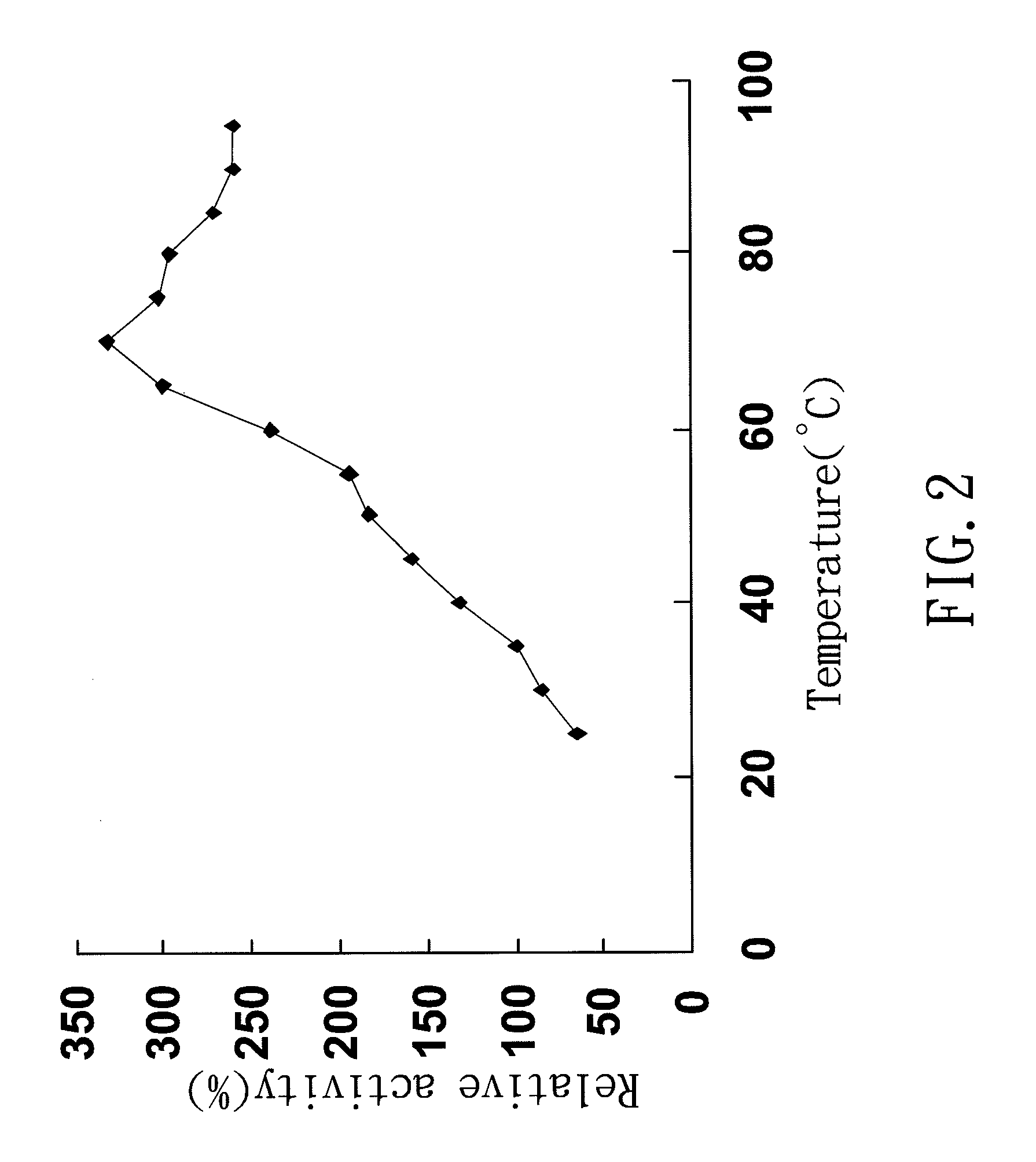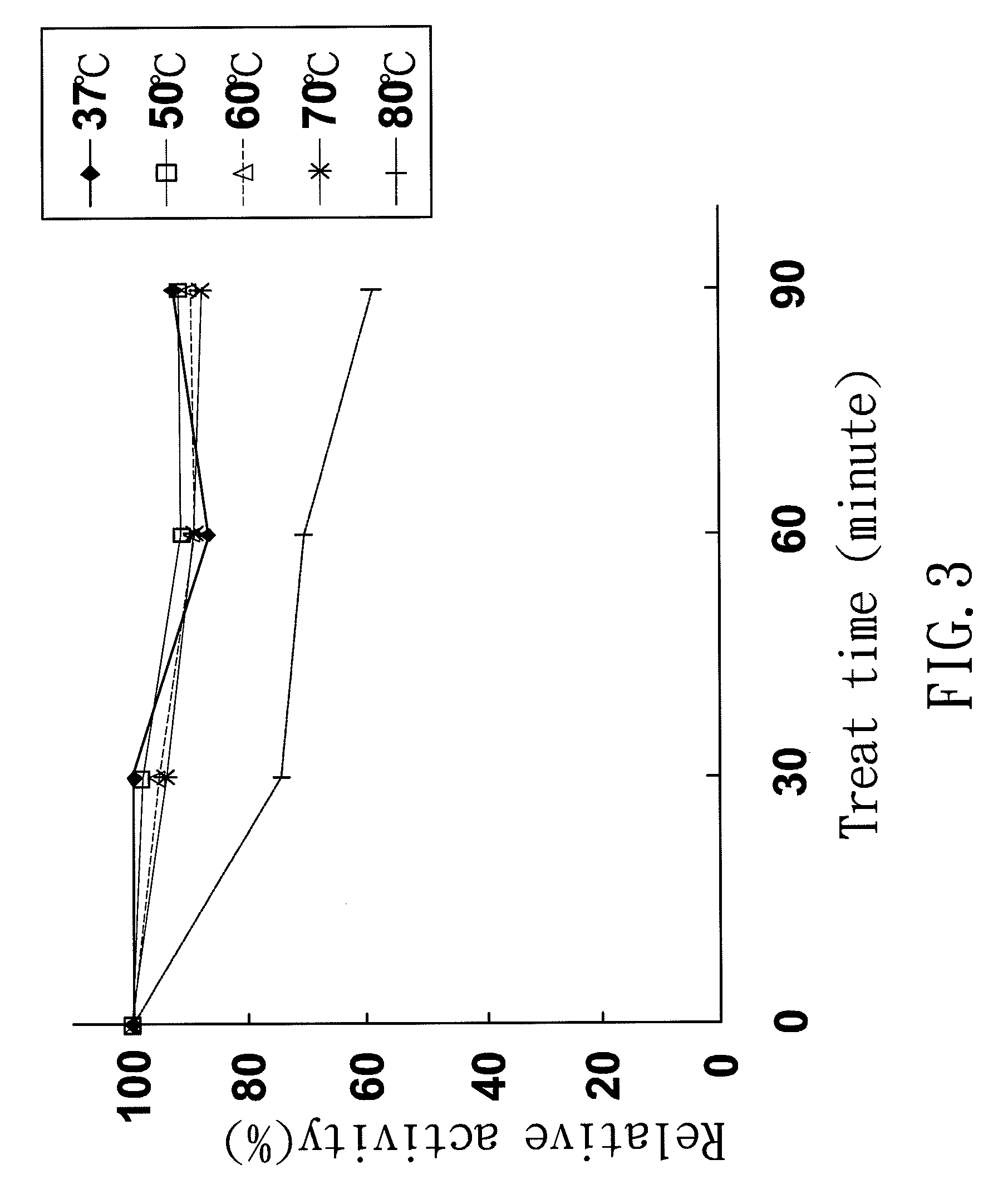Synthesis method of aromatic amino acids
a technology of aromatic amino acids and synthesis methods, which is applied in the direction of enzymology, peptides, transferases, etc., can solve the problems of d/sub>-hpa being a poor raw material for current aceis, affecting the synthesis efficiency of aromatic amino acids, etc., to achieve the effect of shortening the time and improving the efficiency
- Summary
- Abstract
- Description
- Claims
- Application Information
AI Technical Summary
Benefits of technology
Problems solved by technology
Method used
Image
Examples
example 1
Preparation of Recombinant Thermus thermophilus Aspartate Aminotransferase by Gene Cloning
[0031]Isolation of genomic DNA from Thermus thermophilus
[0032]A Thermus thermophilus used in the invention was bought from Bioresource collection and research center (BCRC), Hsinchu, Taiwan. The genomic DNA of Thermus thermophilus was isolated according to the method as described by Sambrook et al. 1989. The Thermus thermophilus was incubated in a 10 ml Thermus medium at 60° C. overnight. The T. thermophilus was harvested by centrifuging 5 ml of the overnight culture at 14,000 rpm for 30 seconds. Removing the supernatant and adding 377 μl of 50 mM TrisHCl (pH8.0) to suspend the pellet. Then 2 μl of proteinase K (20 mg / ml) and 20 μl of 10% SDS was added, mixed well and incubated at 37° C. for 1 hour. The treated mixture was then added with 95 μl of 4.1 M NaCl and 55 μl of 10% CTAB sequentially and incubated at 65° C. for 10 minutes. TrisHCl buffer-saturated phenol was used to extract the mixtur...
example 2
Enzyme Assay in Different Conditions
[0036]This activity of TtAspAT was determined by a modified malate dehydrogenase (MDH) coupling method (Ziehr, H. and M. R. Kula, 1985). A mixture contained 200 mM L-aspartate, 25 mM α-KG, 0.15 mM NADH, 0.1 mM PLP, 5 U of MDH, and 100 mM TrisHCl buffer (pH 8.0), was prepared in a total volume of 1 ml. The reaction was initiated by adding a diluted TtAspAT and proceeded at specific temperature. The decrease of absorbance at 340 nm due to consumption of NADH was monitored for 3-5 minutes and was then converted to enzyme activity. One unit of enzyme activity was defined as the amount of enzyme that catalyzed the production of oxaloacetate equal to 1 μmole NADH consumed for converting oxaloacetae to malate per minute. The preferred embodiment of the present invention examines the optimal catalysis temperature and stability of TtAspAT
[0037]The TtAspAT activity in different temperature was determined under standard reaction mixture in every 5° C. increa...
example 3
High Performance Liquid Chromatography (HPLC) Analysis of TtAspAT Activity Against Homophenylpyruvate
[0039]The high performance liquid chromatography (HPLC) analysis of TtAspAT against homophenylpyruvate was performed by the method modified from Houng, J. Y. and C. L. Hsieh (1996, U.S. Pat. No. 5,552,317). A reaction mixture contained 200 mM aspartate, 25 mM homophenylpyruvate, 100 mM Tris-HCl buffer (pH8.0), 5 U of TtAspAT in a final reaction volume of 1 ml was prepared. The reaction mixture was aliquoted into 0.12 ml for each microtube and incubated at 60° C. for 1, 2, 4, 6, 8 and 12 hours individually. Reaction was stopped by adding 35 μl of 6N HCl. The amount of homophenylalanine (HPA) produced by TtAspAT catalyzed bioconversion was then measured by the HPLC using a reverse phase C18 column (Ascentis C18, 250 mm×4.6 mm, particle size 5 μm, SUPELCO, PA). The mobile phases were an A solvent contained 10% methanol / perchloric acid (pH 2.0) and a B solvent contained 80% methanol / perc...
PUM
| Property | Measurement | Unit |
|---|---|---|
| Temperature | aaaaa | aaaaa |
| Temperature | aaaaa | aaaaa |
| Temperature | aaaaa | aaaaa |
Abstract
Description
Claims
Application Information
 Login to View More
Login to View More - R&D
- Intellectual Property
- Life Sciences
- Materials
- Tech Scout
- Unparalleled Data Quality
- Higher Quality Content
- 60% Fewer Hallucinations
Browse by: Latest US Patents, China's latest patents, Technical Efficacy Thesaurus, Application Domain, Technology Topic, Popular Technical Reports.
© 2025 PatSnap. All rights reserved.Legal|Privacy policy|Modern Slavery Act Transparency Statement|Sitemap|About US| Contact US: help@patsnap.com



